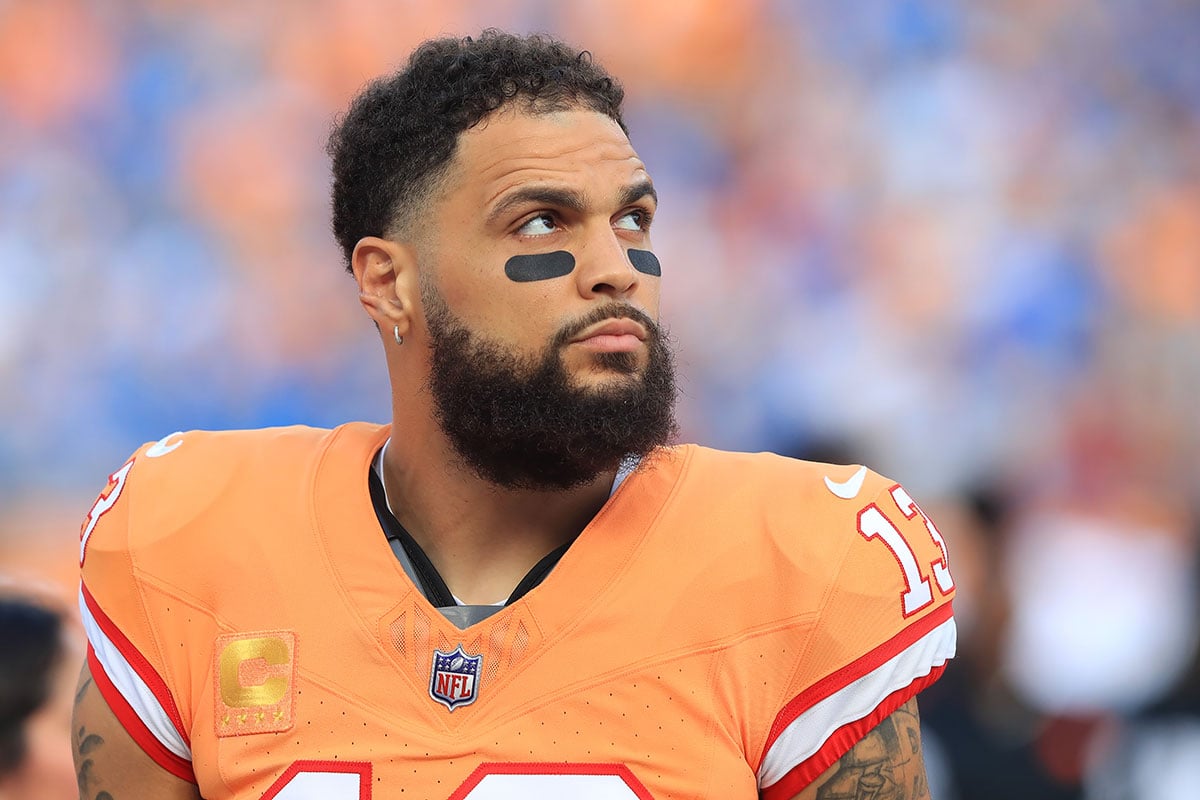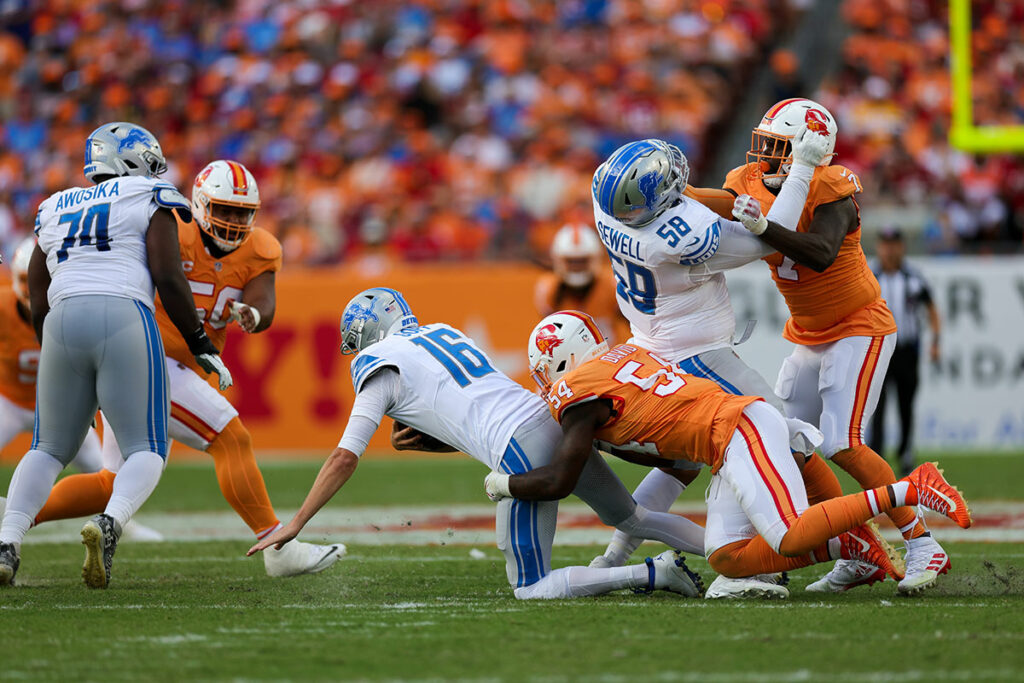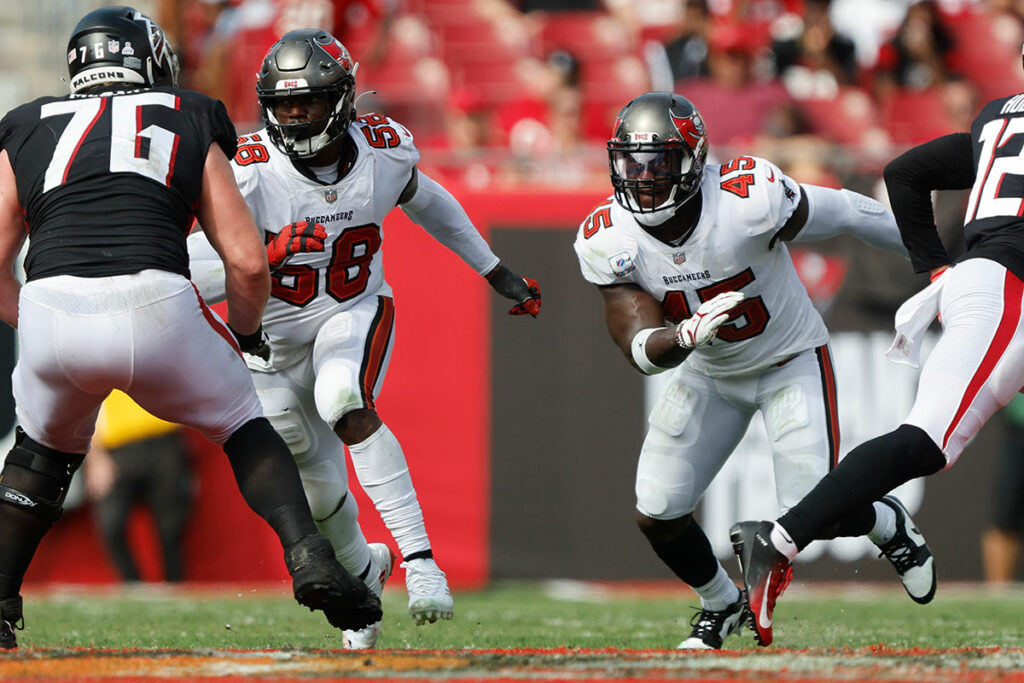Welcome to SR’s Fab 5 – my weekly insider column on the Bucs that features five things that are on my mind. SR’s Fab 5 is now a quicker read, but still packs a punch.
FAB 1. Is Mike Evans Losing His Grip On A Contract Extension?
Halloween is around the corner and it’s officially spooky season.
Plenty of Bucs fans have been spooked by what they’ve seen from Mike Evans this season, who already has at least three drops.
After a hot start to the year in which he had 17 catches for 297 yards and three touchdowns in the first three games of the year, Evans has cooled off considerably over the last two games. A hamstring injury in the first half of the Bucs’ 26-9 win at New Orleans in Week 4 limited him to three catches for 40 yards.
In his return to action last week, Evans was targeted 10 times and caught just four passes for 49 yards – all of which came in the second half. Evans also had a key drop that would’ve picked up a first down on third down.
With 24 catches for 386 yards (16.1 avg.) on the season, Evans is still on pace for his 10th straight 1,000-yard season in an all-important contract year. But the future Hall of Famer has seen his weekly production dip to 77.2 receiving yards per game. Evans needs to average 55.8 yards per game over the next 11 weeks to reach 1,000 yards, but he’s only produced 40 yards and 49 yards in his last two outings.
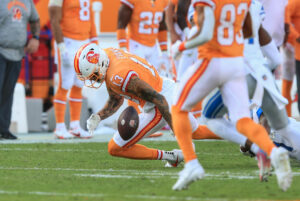
Bucs WR Mike Evans – Photo by: Cliff Welch/PR
Even more worrisome is the fact that Evans has dropped a few key passes so far this year, including potential touchdowns against Minnesota and Philadelphia, and had a big dropped third down catch versus Detroit. Drops are an unofficial statistic and determining what could be considered a drop can be subjective.
Pro Football Reference has Evans with four drops on the season, which is the third-most behind Puka Nacua’s six and Alexander Mattison’s five. Pro Football Focus has Evans with three drops and an 11.1% drop rate. That’s very high considering Evans only had four drops last year on 127 targets per PFF, which was a more reasonable 4.6% drop rate.
Here’s a look at Evans’ drops and drop rate each year per PFF.
2022: 4 drops – 4.6%
2021: 6 drops – 6.2%
2020: 9 drops – 10%
2019: 7 drops – 9.5%
2018: 7 drops – 7.5%
2017: 4 drops – 5.3%
2016: 7 drops – 6.8%
2015: 15 drops – 16.9%
2014: 4 drops – 5.6%
If Evans keeps up this pace, he’ll finish with 10 drops this season, which will be the second-highest total of his career.
Yikes.
Not exactly ideal in a big contract year.
In 2015, Evans had a five-drop game in a 32-18 loss to the New York Giants, and finished that season with 15 dropped passes.
Mike Evans has 5 drops today, tied for the most drops in a game in the last 10 seasons (Brandon Jacobs, Week 15 of 2007 vs WSH)
— ESPN Insights (@ESPNInsights) November 8, 2015
Bucs offensive coordinator Dave Canales isn’t worried about Evans’ drops.
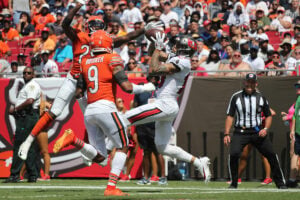
Bucs WR Mike Evans – Photo by: Cliff Welch/PR
“No, you guys (the media) have been around him – this is the best receiver I’ve ever been around,” Canales said. “As Mike continues to work through whatever those things are, I can’t imagine … He’s going to figure out a way to get through that. You can’t talk about a few drops without the fantastic plays that he’s made.
“You’re probably going to see us test out his leg and stamina. On that first play where we got it tipped and it turned into an interception, he was going to have to see if he could go 90 yards and not get caught there. We’re going to continue to feature Mike. He’s going to be No. 1 in progressions a lot of times – [that is] just the way we’ve been building it. We’ll live with those plays.”
The amount of Evans’ big plays will surely outnumber his drops this year. But the drops will factor in to how much Evans gets paid next year – whether it’s in Tampa Bay or elsewhere, as the 30-year old receiver seems poised to hit free agency. The Bucs have yet to offer Evans a contract, and his agent shut down any more talks last month prior to kickoff in Week 1 so his client could focus on the season.
But could the uncertainty of where he will play next year be a culprit on Evans’ ability to focus on the ball? Given his age, this will be Evans’ last big contract in the NFL, and he wants to cash in on a deal that would make him one of the highest-paid receivers in the game.
Evans’ early drops aren’t helping.
Making an average of $16.5 million per year, Evans is the league’s 17th highest-paid receiver. For the past two seasons, teammate Chris Godwin has been making more with an average of $20 million per year. Godwin is the NFL’s 13th highest-paid receiver and is coming up on a contract year in 2024.
If Evans is seeking to be among the Top 5 highest-paid receivers in the league, that would put him at around $24 million-$25 million per year. Miami’s Tyreek Hill is the highest-paid receiver at $30 million, followed by Las Vegas’ Davante Adams at $28 million and Los Angeles’ Cooper Kupp at $26.7 million. Philadelphia’s AJ Brown is next at $25 million, followed by Buffalo’s Stefon Diggs and Seattle’s DK Metcalf at $24 million each.
Hill leads the NFL with 814 yards and six touchdowns on 42 catches, while Brown is right behind with 672 yards and two TDs on 42 catches. Diggs ranks third with 620 yards and five scores on 49 catches. Adams is 12th with 471 yards and three TDs on 39 catches.
Evans ranks 18th in the league in receiving with 386 yards and three touchdowns on 24 catches, but the Bucs did have an early bye in Week 4.
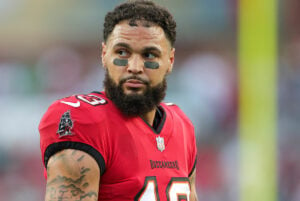
Bucs WR Mike Evans – Photo by: USA Today
In order to potentially justify such a huge pay raise in Tampa Bay or elsewhere, Evans needs to catch as many passes as he can to catch up – and avoid drops.
Next year, the Bucs have a huge decision to make on Evans, who will turn 31 in August. It’s hard to see how Tampa Bay’s offense would be better off without Evans in 2024.
Life without Mike Evans could be downright scary for the Buccaneers.
But that leaves the Bucs in a bit of a conundrum. Is Evans playing well enough to where he justifies earning a massive raise of around $8 million per year to get to $25 million, where he’s making about $5 million more than Godwin?
Right now, it’s hard to make that argument given Evans’ recent decline in production and his early-season drops. But there are 11 more games to go. Evans needs to pick it up – and hang on to the ball.
The good news for Evans is that Atlanta is coming to town, and he’s had more success against the Falcons than any other team, catching 85 passes for 1,317 yards (15.5 avg.) and 10 touchdowns.
FAB 2. For Bucs, The Decision At WR Will Be Mike Evans OR Chris Godwin
Nobody is saying it out loud, but one of the main reasons why the Bucs did not offer Mike Evans a contract extension prior to the start of the 2023 season is because of Chris Godwin.
The 27-year old receiver is in the middle of a three-year, $60 million contract with one year remaining in 2024. Then, Godwin will be a free agent entering a season where he’ll be 29 years old.
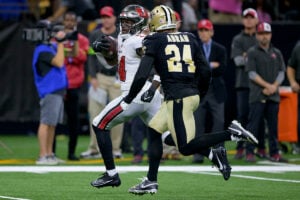
Bucs WR Chris Godwin – Photo by: USA Today
Not only are the Bucs evaluating the play of Evans this season to determine how much money he would command in free agency should they want to extend his contract, Tampa Bay is doing the same thing with Godwin.
Should Evans fetch a contract offer somewhere between $20 million-$25 million next March, the Bucs will have to determine whether they want to keep him or Godwin. Tampa Bay likely won’t fork out the money to keep both. Not with massive deals coming for right tackle Tristan Wirfs and safety Antoine Winfield Jr., and perhaps inside linebacker Devin White and quarterback Baker Mayfield, too.
If the Bucs decide to keep Evans and extend his contract for three years or more, that will likely mean that Tampa Bay will have to walk away from Godwin, who will surely command a pay raise over his current $20 million status. Let’s suppose Evans is re-signed for $23 million per year, perhaps giving the Bucs a hometown discount. That would be a $6.5 million raise for Evans.
Now Tampa Bay would be paying $43 million for both receivers during the 2024 season. Right now, the team is paying $36.5 million for both.
Evans is no longer discussing his contract status, but did say prior to the start of the regular season that he could see the Bucs paying both he and Godwin $20 million or more.
“Absolutely, I think other teams have done something similar,” Evans said. “But this is my last time talking about contract situations. I’m looking forward to having a great season this year, and whatever happens, happens. I’ll be alright.”
In fact, only one NFL team has two receivers making $20 million per season and that’s the Los Angeles Chargers. Keenan Allen, who is 31, makes $20.025 million, while Mike Williams, who is 29, makes $20 million.

Bucs WRs Chris Godwin and Mike Evans – Photo by: Cliff Welch/PR
The league’s most expensive duo is actually Seattle’s DK Metcalf, who makes $24 million, and Tyler Lockett, who makes $17.3 million. Metcalf is only 26, while Lockett is 31. The two combine to make $41.3 million.
When Godwin hits free agency after 2024, it’s only natural that he would want more money than he accepted three years ago. So pencil Godwin in for the same $23 million as Evans might theoretically make, and now Tampa Bay is paying $46 million in 2025 for receivers who are 32 (Evans) and 30 (Godwin).
After paying big money to a pair of players in their 30s in outside linebacker Shaq Barrett and center Ryan Jensen only to see them miss time with significant injuries, I don’t think the Glazers would invest massive new contracts for both Evans and Godwin.
If that’s the case, which one do the Bucs keep? That’s what the team will spend this season deciding – which one is a better fit in Dave Canales’ offense, and who can’t Tampa Bay live without.
Evans has a penchant for making bigger plays, but Godwin is a more reliable receiver in terms of avoiding dropped passes.
Here’s a look at Godwin’s drops and drop rate each year per PFF.
2023: 0 drops – 0%
2022: 5 drops – 4.2%
2021: 5 drops – 4.9%
2020: 9 drops – 10% (5 came vs. Washington in playoff win)
2019: 1 drop – 1.1%
2018: 1 drop – 1.7%
2017: 2 drops – 5.6%
Keep in mind if Evans is re-signed, Godwin won’t be cut. Tampa Bay would structure Evans’ deal to where both would be able to fit under the cap in 2024, but Godwin would then hit free agency the next offseason in 2025.
It will be fascinating to see how the Bucs’ receiver situation plays out the rest of the year and into the offseason and which one Tampa Bay ultimately decides to keep.
FAB 3. Tight Ends Letting Bucs Down
While the Bucs are currently flush at the receiver position and fortunate to have two 1,000-yard Pro Bowl-caliber wideouts in Mike Evans and Chris Godwin, the team is not so lucky at tight end. Not only is Tampa Bay’s tight end room the youngest in the NFL, it’s also the least productive across the league.

Bucs TE Cade Otton – Photo by: Cliff Welch/PR
Through five games, the Bucs tight ends have combined for just 16 catches for 102 yards and one touchdown. That’s an average of three catches for 20 yards per game. Starter Cade Otton leads the way with 13 catches for 104 yards and one score. His paltry 8.0 average is worse than last year when he averaged just 9.3 yards per catch, which isn’t good, either.
The Bucs were hopeful that Otton could build on a decent rookie year where he caught 42 passes for 391 yards and scored two touchdowns, including the game-winner against the Rams. Otton, last year’s fourth-round pick, does not look like a starting-caliber, playmaking tight end. He looks like a second- or third-string tight end, especially as a blocker.
For all of the criticism the offensive line has taken with the team’s struggles to run the ball, Tampa Bay’s tight ends, including Otton, have been just as big of a culprit.
Backup tight end Ko Kieft is primarily a blocking tight end and doesn’t have a catch this year. He was targeted three times in the passing game in Week 1, which was a lesson offensive coordinator Dave Canales quickly learned. The problem in deploying Kieft is that he’s so one-dimensional that when he’s on the field, it’s often a tell for opposing defenses that the Bucs plan on running the ball.
David Wells was benched after a poor start to the season. He has two catches for minus-8 yards due to a fumble occurring on one of his receptions. Rookie Payne Durham, a fifth-round pick, was inactive until Sunday’s game where he caught his first pass for eight yards. Durham was a decent receiver in college, but is not fleet of foot.
The problem with the Bucs’ tight end unit is that there is not a playmaker among the group that can threaten a defense with speed or tackle-breaking ability. It’s not that Tampa Bay no longer has a Rob Gronkowski who was capable of taking over a game. It’s that the Bucs don’t even have a guy like Cam Brate, who in his prime was a receiving tight end capable of attacking the seam and producing a 70-yard game.
Tampa Bay will have to play with the current stable of tight ends, although Tanner Taula is available on the practice squad. Bucs offensive coordinator Dave Canales still believes in the unit and suggests that the best is yet to come from the young tight ends.
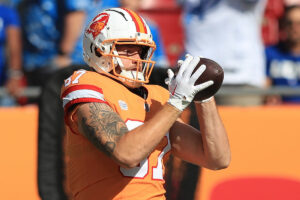
Bucs TE Payne Durham – Photo by: Cliff Welch/PR
“I believe so,” Canales said. “I think, again, it’s not just one group, it’s all of us, the coaches included. As we grow in this offense, then we’ll be able to see more production. Again, when the tight ends get targeted, typically you’ve got Chris and Mike out there and the tight end is going to be a complement to a rolled coverage or something, where they’re paying a lot of attention [to] those guys. That’s where the tight end starts to become available.
“I really love the group, I love how smart they are – they work tirelessly. [Tight ends coach] John Van Dam does a great job with them. I think the whole group will elevate as we continue to grow.”
The Bucs won’t likely be able to upgrade the position until next offseason, and tight end needs to be considered a priority for general manager Jason Licht. Tampa Bay loved Sam LaPorta and was hopeful he could be the team’s second-round pick, but Detroit drafted him with the second overall selection in Round 2.
Last year’s draft featured a banner crop of tight ends and the Bucs did use a Day 3 pick on Durham. But all Tampa Bay has is a trio of Day 3 tight ends now in Otton, Kieft and Durham and not a true, starting-caliber tight end as a result. The 2024 NFL Draft will not be nearly as robust as last year’s at tight end, so the position will have to be prioritized next April if Licht can’t find an upgrade in free agency.
Sunday will be National Tight Ends Day in the NFL. The Bucs need to shut down the Falcons’ tight ends – and hope their own tight ends are far more productive than they’ve been so far this year.
What would we do without TEs?! 🔥
📺: #NationalTightEndsDay – Sunday, Oct. 22 pic.twitter.com/OHm7pkOwuh
— NFL (@NFL) October 19, 2023
FAB 4. Falcons TEs Have Bucs Concerned
While the tight end position in Tampa Bay is a clear weakness, it’s a team strength in Atlanta. The Falcons have not just one talented tight end to contend with, they actually have two.
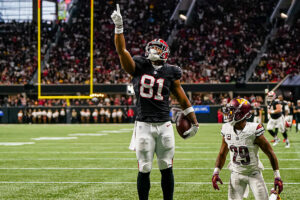
Falcons TE Jonnu Smith – Photo by: USA Today
Second-year wide receiver Drake London leads the Falcons in receiving with 26 catches for 329 yards (12.7 avg.) and two touchdowns, but the next two leading receivers in Atlanta are tight ends Jonnu Smith and Kyle Pitts.
Smith, a seventh-year veteran, has spent time in Arthur Smith’s offense back in Tennessee. He’s actually out-producing Pitts, a former first-round pick, by a slight margin. Smith has 25 catches for 282 yards and one touchdown, while Pitts has 22 receptions for 251 yards and one score.
The Falcons deploy a lot of two-tight end sets, which give the illusion that the offense wants to run either first-round pick Bijan Robinson or 2022 1,000-yard rusher Tyler Allgeier. But with Smith and Pitts as capable weapons in the passing game, Atlanta easily deploys both tight ends as receivers out of that formation, too.
“That’s what we are spending a lot of time on is the personnel [groupings],” Bucs co-defensive coordinator Kacy Rodgers said. “They have 12 [personnel] that can look so many different ways. You’ve got 12 with ‘85’ (MyCole Pruitt) in there. Then you’ve got 12 with ‘8’ (Kyle Pitts) in there – ‘8’ and ‘81’ (Jonnu Smith) is going to look different than 12 with ‘8’ and ’85.’
“Then in 13 personnel, they’ve got three of them out there. It just poses so many problems because if you go big on them, then they open the set and you can have problems. You go small, and now how are you going to stop the run? What they’re doing schematically with their personnel poses a lot of problems, which we’re trying to answer now.”
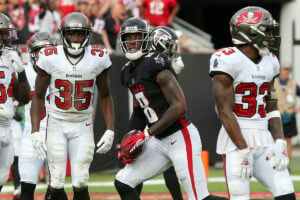
Falcons TE Kyle Pitts – Photo by: Cliff Welch/PR
On first down, which is when offensive coordinators can call any play they want, Atlanta is in 12 (two tight ends) or 13 (three tight ends) personnel 44% of the time. That’s tied with Jacksonville for the fifth-most usage in the NFL. Tennessee leads the league with 51% usage, followed by Kansas City (48%) New England (47%) and the Los Angeles Chargers (47%).
Additionally, the Falcons tight ends have played 694 total offensive snaps collectively, which is No. 1 in the league.
“It’s a big challenge because it’s not just the tight ends – it’s the wide receivers and the running backs as well,” Bucs head coach Todd Bowles said. “[Desmond] Ridder can also run with the football, as well as throw it, so we’ve got to play disciplined football. We’ve got to win our one-on-one matchups when opportunities arise because they don’t have just two tight ends, they have a full arsenal where they can take advantage of you.”
Most NFL teams have one starting-caliber tight end to contend with in the passing game, like Detroit had last week with rookie Sam LaPorta. But with Atlanta, it’s double trouble at tight end, as either Smith or Pitts is a threat to make a big play across the middle or score in the red zone.
FAB 5. First Sack Coming For YaYa Diaby vs. Falcons?
The Bucs have 15 sacks through five games and are averaging three QB captures each outing. Nose tackle Vita Vea leads the team with 3.5 sacks, but in Todd Bowles’ defense, anyone can get to the quarterback due to his myriad of blitzes. Nine different defenders have at least half a sack this season, including four of the team’s five regularly used outside linebackers.

Bucs OLB YaYa Diaby – Photo by: Cliff Welch/PR
The lone edge rusher who has yet to record a sack is YaYa Diaby, the team’s third-round pick. But after first-round pick Calijah Kancey notched his first NFL sack last week against the Lions, the rookie outside linebacker is due and could get his first one on Sunday against Atlanta.
“My preparation for this week has been keyed in on me getting my first sack,” Diaby said. “I’ve got to get mine. I’ve been preparing really hard to get my first one this week.”
Falcons quarterback Desmond Ridder has been sacked 19 times in six games so far this season. The Bucs’ film study shows that there will be opportunities to get to Ridder on Sunday in what could be a sack attack for Tampa Bay. If there is ever a week for Diaby to dial up his first sack, it could be against Atlanta’s tackles, who have surrendered six sacks between left tackle Jake Matthews (four) and right tackle Kaleb McGary (two).
“It’s YaYa time every time,” Bucs outside linebacker Joe Tryon-Shoyinka said. “He’s going to pop off one of these weeks. He’s definitely due. He just wants to learn so much. He’s not just satisfied knowing the play. He wants to do it right and figure out ways to get better. His energy and his enthusiasm are amazing, on top of him being a physical specimen.”
YaYa Diaby (@greatyaya4) is going to be special. The ability to recover here and make the tackle is ridiculous! #Bucsfilm2023wk6 pic.twitter.com/rk4DmuLsAT
— Steven Cheah (@StevenCheah) October 18, 2023
Bucs co-defensive coordinator Kacy Rodgers is excited by Diaby’s development so far. Diaby has seven tackles, including a tackle for loss, with a pair of QB pressures in his reserve role.
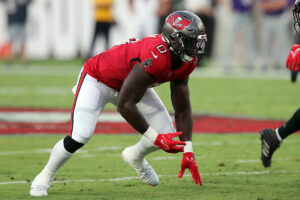
Bucs OLB YaYa Diaby – Photo by: Cliff Welch/PR
“He’s one of our better rushers now, but the thing is finding the role for him because right now… Joe and Shaq [Barrett], you like them on the field. And with Calijah back now, and Vita, where do you put him? He’s a good inside rusher. He can wear a lot of hats for us. We’re going to keep going forward, and as we know, we’re going to need everybody. We know what we’ve got in him and right now he is a luxury, but he’s definitely made strides in the rush.”
The key to being able to rush the passer is stopping the Falcons’ potent run game on first and second down and get Ridder into predictable passing situations on third-and-long.
“This week we’re trying to stop the run,” Diaby said. “They like to run outside zone, so we have to make sure we do our job setting the edge. That’s going to help us make sure we get into third-and-longs where we go and rush the passer.
“Coach is setting us free this week. He’s letting us go. I’m excited about that. I think everyone on the front line is going to do some numbers.”
Scott Reynolds is in his 30th year of covering the Tampa Bay Buccaneers as the vice president, publisher and senior Bucs beat writer for PewterReport.com. Author of the popular SR's Fab 5 column on Fridays, Reynolds oversees web development and forges marketing partnerships for PewterReport.com in addition to his editorial duties. A graduate of Kansas State University in 1995, Reynolds spent six years giving back to the community as the defensive coordinator/defensive line coach for his sons' Pop Warner team, the South Pasco Predators. Reynolds can be reached at: [email protected]

